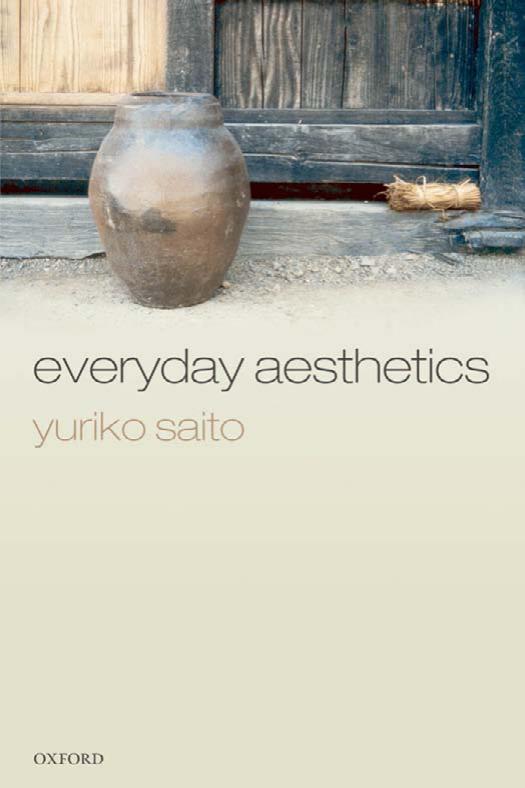Everyday Aesthetics by Yuriko Saito

Author:Yuriko Saito
Language: eng
Format: epub, pdf
Publisher: Oxford University Press
Published: 2007-03-13T16:00:00+00:00
2. Appearance of aging
i. Sensuous qualities of aged surface
Although the aesthetic appreciation of messy and disorderly appearance does exist and our appreciation of order and neatness is context-dependent, in our common life there is a stronger preference for clear, coherent, organized, orderly appearance. The same thing applies to the qualities illustrative of aging. The general norm seems to be in favor of the youthful appearance of an optimal state without blemishes and signs of decay. Indeed, in his research into different aesthetic reactions to “the look of age,” gathered primarily from various historical examples in the West, David Lowenthal, a cultural geographer, points out that “the balance of evidence … shows general dislike of age and decay,” and that “we prefer youth, not only in living creatures but in our surroundings, including our own creations.” Those instances of the celebration of the look of age, he observes, are “the exception.”53
It is noteworthy that the two prominent aesthetic movements advocating the positive aesthetic qualities of aging appearance, the eighteenth-century British picturesque and the Japanese wabi aesthetics, are both premised upon the commonly accepted and understood appreciation of the opposite qualities. For example, the picturesque movement’s celebration of aged appearance is most effectively illustrated by its obsession with ruins. However, Lowenthal points out that in England, ruins, such as castles and abbeys, were not only not appreciated but rather deplored before the eighteenth century: “the mutilated English monasteries were long abhorred, their ‘rotten Foundations, ruinous Arches and Pillars, mouldering and tottering Walls’ arousing general revulsion.”54 Declaring the picturesque aesthetic as “England’s greatest contribution to European visual culture,” Christopher Woodward also points out that “before the Picturesque movement, thatched cottages and creaking windmills were not considered worthy of a designed landscape, nor were Gothic ruins, or gnarled oak-trees, or old walls covered in ivy.”55 The picturesque cult of ruins, therefore, has a particular potency, precisely because of the generally negative attitude toward half-fallen structures.
Or, consider the Japanese wabi sensibility promoted by the tea ceremony, which celebrates those objects and phenomena that are past their prime, such as falling cherry blossoms and chipped tea bowls. Its proponents claim that such a taste is contrary to something that comes naturally; it has to be cultivated. Yoshida Kenkō (1283–1350), a retired Buddhist monk, for example, extols the beauty of cherry blossoms when falling rather than in full bloom, as well as the obscured, rather than unobstructed, view of the moon, by admitting at the outset that “people commonly regret that the cherry blossoms scatter or that the moon sinks in the sky, and this is natural.”56 So, if we can assume that our “natural” attitude toward things showing their age is negative, what accounts for our aesthetic reaction? Are we merely reacting to the sensuous appearance of the aging objects?
When we consider the pure sensuous surface of aging materials, there does not seem to be a consensus as to what features are aesthetically appreciable and what are not. The appearance of aging takes different forms. Sometimes the surface becomes smoother and simpler through weathering and repeated use.
Download
This site does not store any files on its server. We only index and link to content provided by other sites. Please contact the content providers to delete copyright contents if any and email us, we'll remove relevant links or contents immediately.
The remains of the day by Kazuo Ishiguro(8814)
Tools of Titans by Timothy Ferriss(8211)
Giovanni's Room by James Baldwin(7188)
The Black Swan by Nassim Nicholas Taleb(7009)
Inner Engineering: A Yogi's Guide to Joy by Sadhguru(6722)
The Way of Zen by Alan W. Watts(6503)
Asking the Right Questions: A Guide to Critical Thinking by M. Neil Browne & Stuart M. Keeley(5629)
The Power of Now: A Guide to Spiritual Enlightenment by Eckhart Tolle(5603)
The Six Wives Of Henry VIII (WOMEN IN HISTORY) by Fraser Antonia(5394)
Astrophysics for People in a Hurry by Neil DeGrasse Tyson(5130)
Housekeeping by Marilynne Robinson(4328)
12 Rules for Life by Jordan B. Peterson(4249)
Double Down (Diary of a Wimpy Kid Book 11) by Jeff Kinney(4204)
The Ethical Slut by Janet W. Hardy(4172)
Skin in the Game by Nassim Nicholas Taleb(4161)
Ikigai by Héctor García & Francesc Miralles(4123)
The Art of Happiness by The Dalai Lama(4063)
Skin in the Game: Hidden Asymmetries in Daily Life by Nassim Nicholas Taleb(3929)
Walking by Henry David Thoreau(3892)
